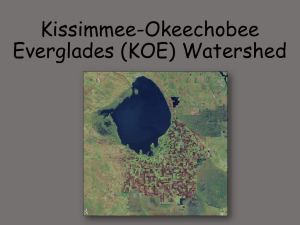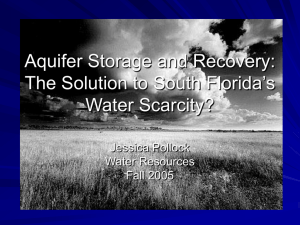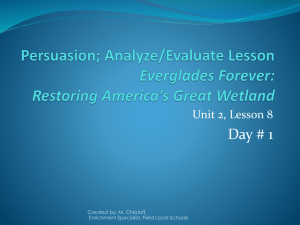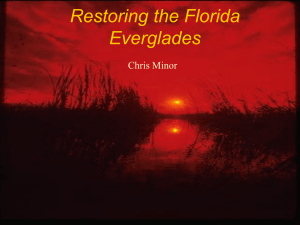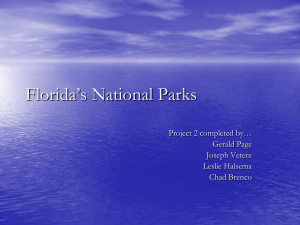Everglades Hydrology: Competing Water Management Goals
advertisement
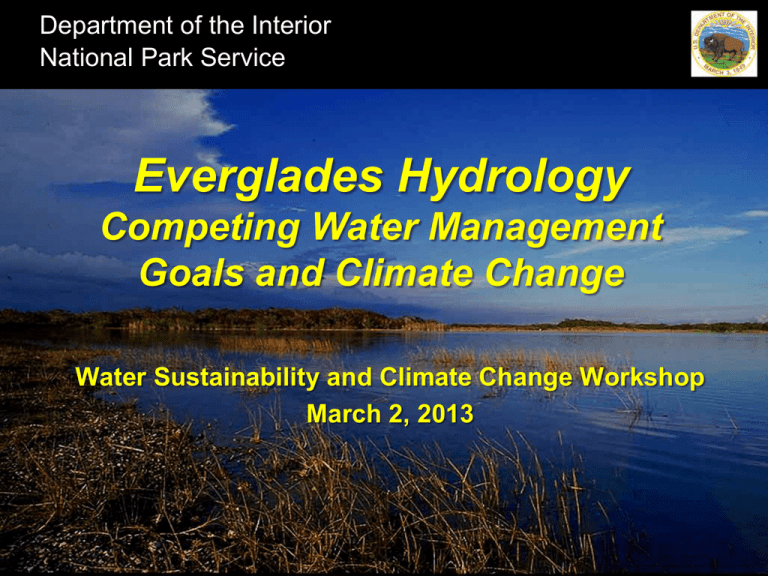
Department of the Interior National Park Service Everglades Hydrology Competing Water Management Goals and Climate Change Water Sustainability and Climate Change Workshop March 2, 2013 Presentation Outline • • • • South Florida Ecosystem Kissimmee-OkeechobeeEverglades Watershed (10,900 mi2 / 28,200 km2). The watershed extends 310 mi/450 km from north to south and 62 mi/100 km east to west. • Key Drivers of the Hydrologic Evolution of the Everglades Lake Okeechobee : Managing for a Natural Lake or Water Supply Reservoir Balancing Everglades Water Quality & Water Flow (the EAA) Restoring Sheetflow and Marsh Connectivity in the WCAs & ENP Balancing Everglades Seepage Mgmt. and Protection of Urban Water Supply/Flooding Colored boundary corresponds with the South Florida Water Management District, and the dark green and dark blue areas represent publicly managed lands/waters. Key Drivers of Water Management Changes Private Drainage Projects through the Central and Southern Florida (C&SF) Project • • • • • • • • Reconstructed Pre-drainage Landscapes, source: McVoy et. al., 2011. Swamplands Act (1850) 20 million acres deeded for drainage/reclaimation Navigation/Drainage (1890’s) Caloosahatchee River Connection Drainage (1910 – 1920’s) Four Major East Coast Canals Drainage/Flood Control (1915 – 1930’s) Herbert Hoover Dike/Saint Lucie Canal Urban Flood Control (1950’s) Eastern Protective Levee System Agricultural Flood Control (1950’s) Everglades Agricultural Area Levees Urban Water Supply (1960’s) Water Conservation Area Levees Environ./Ag. Water Supply (1980’s) South Dade Conveyance System Source: Light and Dineen, 1994 Changes in Landscape Patterns Pre-Drainage (1890’s) Ag. & Urban Expansion (1970’s) Early Development (1950’s) Source: Renken et al. 2000 Current Build-Out (1990’s) Topographic Changes in the Everglades Generalized Pre-drainage Topography, source: McVoy et. al., 2011. Generalized Topography in 1940, source: McVoy et. al., 2011. Current Landscapes and Water Management • Lake Okeechobee multipurpose reservoir, covers 730 mi2 and has a storage capacity of 2,250,000 acre-feet, enclosed by the Herbert Hoover Dike. • • • • Current Post-drainage Landscape, source: SFWMD. Everglades Agricultural Area cover 700,000 acres. Annual water supply demands are approx. 350,000 ac-ft and approx. 1,160,000 ac-ft are discharged for flood protection. Water Conservation Areas multipurpose reservoirs, remnant Everglades, cover 1,370 mi2 and have a storage capacity of 1,880,000 ac-ft. Lower East Coast urban areas, receive approx. 980,000 ac-ft of groundwater seepage from the Everglades, 280,000 ac-ft of water supply deliveries, and discharge approx. 3,190,000 ac-ft to tide or the Everglades for flood protection. Everglades National Park protected area covering 1,500,000 acres, receives approx. 975,000 ac-ft of surface water deliveries, with outflows to tide of approx. 1,860,000 ac-ft. Source: SFWMD, 2000B2 water budget. Alterations in Surface Water Flows (Volumes and Timing) Shark River Slough GOAL: Begin to restore the hydrologic connection between Lake Okeechobee and the Everglades. River of Grass Restoration Planning Workshops, source: SFWMD, 2010. REQUIREMENTS: Increased upstream water storage and water quality treatment. Management of Lake Okeechobee • Historically, Lake Okeechobee served as the hydrologic link between the riverine and upland habitats in the Kissimmee watershed and the Everglades wetlands and downstream estuaries, moderating the effects of droughts and floods. • Today the Lake is managed to balance the needs of the Lake’s natural resources, protect the integrity of the HH Dike, and provide water supply deliveries to the Lake Okeechobee Service Area. Lake Stage 12 feet Volume 2.72 M ac-ft Lake Stage 15 feet Volume 3.98 M ac-ft Herbert Hoover Dike Rehabilitation High Lake Okeechobee water levels in 2004/2005 raised concerns over the integrity of the 143-mile long Herbert Hoover Dike, leading to a reduction in operational levels in 2007. A new Lake Okeechobee Operational Schedule (LORS 2008) was put in place to protect the HHD and improve the health of the Lake’s nearshore and littoral zones. The HH Dike Rehabilitation project has replaced 3 aging water control structures and constructed 21 miles of cutoff walls, at a cost just over $300M. Balancing Water Quality and Water Flow (the EAA & Water Quality Challenges) The Everglades wetlands were naturally oligotrophic with total phosphorus concentrations less than 10 parts per billion (ppb). Excessive nutrients in the stormwater leaving the Everglades Agricultural Area have caused documented imbalances in native flora & fauna. In 1988 the Federal government sued the State of Florida for water quality violations within Everglades N.P. and the Lox. National Wildlife Refuge. A settlement was reached in 1992. GOAL: Improve the quality of stormwater entering the Everglades, to allow the restoration of sheetflow and marsh connectivity. Current Water Quality Protection Initiatives Everglades Construction Project (ECP) Began in 1994, to reduce TP concentrations and loads from the EAA to protect the Everglades. 57,000 acres of Stormwater Treatment Areas (STAs) and agricultural BMPs have lowered TP to 19-58 ppb, with load reductions of 7080% EAA-wide. Florida’s Phosphorus Rule In 2002 the State set a Total Phosphorus Limit at 10 ppb to protect the Everglades from imbalances in native flora/fauna. Flows and TP in Shark River Slough 11 Planned Everglades Water Quality Projects Restoration Strategies 2012-2016 • • Eastern Flow-Path: 45,000 acre-foot Flow Equalization Basin 2012-2016 2013-2018 Lake Okeechobee New FEB Central Flow-Path: 54,000 acre-foot Flow Equalization Basin New STA 2013-2018 • 2018-2024 Eastern Flow-Path: 4,700 acres of Stormwater Treatment Area (STA) WCA-1 2018-2024 • • • Eastern Flow-Path: 1,800 acres of STA (2018-2022) Western Flow-Path: 11,000 acre-foot Flow Equalization Basin (20182023) Western Flow-Path: 800 acres of earthwork within existing STAs to maximize effective treatment area (2019-2024) STA 1E STA 1W New FEB and STA Earthwork New FEB STA 5/6 New STA Loxahatchee National Wildlife Refuge STA-2 STA-3/4 WCA-2A WCA-3A Alterations in Surface Water Flows (Spatial Patterns and Directionality) Pre-Drainage Flows (NSRSM) Existing Condition Flows (RSMGL/ECB) source: McVoy et. al., 2011. Alterations in Surface Water Flows (Water Depths & Flooding Durations) GOAL: Redistribute surface water more uniformly by removing barriers to sheetflow. Source: Everglades Depth Estimation Network, USGS. Surface Water Flow Volumes in the Everglades Wet Year Drier Year GOAL: Capture excess water, and return it to the Natural & Built System. Source: Primary Water Budgets, DOI. Comprehensive Everglades Restoration Plan (CERP) “Yellow Book” Included 68 Major Components Orlando Surface Water Storage Reservoirs (170,000 acres, with 560,000 ac-ft storage capacity) In-ground Reservoirs (11,000 ac, 330,000 ac-ft) Aquifer Storage & Recovery wells (4,080,000 ac-ft) Stormwater Treatment Areas (36,000 acres) Wastewater Reuse plants (260,000 ac-ft) Removal of over 240 miles of canals, levees XXXXX Groundwater Seepage Management (80 miles) Rainfall-Driven Water Management Operations Total Projected Cost $19.5 Billion in 2010 Dollars (Includes Foundation & CERP Projects) Lake Okeechobee West Palm Beach Ft. Myers Big Cypress National Preserve Everglades National Park Florida Bay Fort Lauderdale Miami Seepage Management Features & Benefits • Reduce groundwater seepage losses from the Everglades. • Capture & store excess Everglades Agricultural Area stormwater in the Lower East Coast currently going to tide. • Retaining water in the natural system increases the spatial extent of Everglades wetlands (increases water depths and flooding durations). • Careful operations balance, insufficient seepage mgmt. could increase harmful wet season stages, while excessive seepage mgmt. could reduce groundwater recharge in the dry season. Strazzulla Wetlands Lox. NWR WCA-2A WCA-3A 760 WCA 3B ENP Seepage Mgmt. 220 Modified WD, C-111 SD, C-111 SC Seepage Estimates in 1,000 ac-ft from SFWMM, 2000B2.. Central Everglades Planning Project Next CERP Increment 298K Habitat Units Cost Effective 293K Habitat Units Not Cost Effective 317K Habitat Units Not Cost Effective 339K Habitat Units Cost Effective Alt. 1 Avg. Annual Cost $74 M, $250K/HU, Alt. 4 Avg. Annual Cost $84 M, $247K/HU Tentatively Selected Plan (ALT4R) EVERGLADES AGRICULTURAL AREA WCA 1 A-2 A-1 G-206 S-8 WCA 2 L-5 L-28 WCA 3A L-33 S-345D S-345F/G S-333 Tamiami Trail L-67 Ext EVERGLADES NATIONAL PARK I-75 WATER CONSERVATION AREAS WCA L-30 3B L-29 S-335 S-356 S-334 G-211 C-2 STORAGE AND TREATMENT Construct A-2 FEB and integrate with A-1 FEB operations Lake Okeechobee operation refinements within LORS 2008 DISTRIBUTION/CONVEYANCE Diversion of L-6 flows and L-5 canal improvements Spreader canal ~3 miles long, west of S-8 (3,000 cfs) Backfill Miami Canal from ~1.5 miles south of S-8 to I-75 L-28 Triangle – gap levee DISTRIBUTION/CONVEYANCE Increase S-333 capacity to 2,500 cfs Two 500 cfs gated structures in L-67A, spoil removal west of L-67A north and south of structures Relocated L-67A levee to form L-67D Tieback levee in WCA 3B Degrade L-67C levee in L-67D flowway One 500 cfs gated structure north of Blue Shanty levee and 6,000-ft gap in L-67C levee Degrade L-29 levee in L-67D flowway, divide structure east of L-67D Tieback levee at terminus of western bridge Tamiami Trail western 2.6 mile bridge, aligned with L-29 levee removal, and L-29 canal DHW raised to 9.7 ft (FUTURE WORK BY OTHERS) Degrade lower 1.5 miles of L-67 extension levee, backfill canal SEEPAGE MANAGEMENT Increase S-356 to 1,000 cfs Partial depth seepage barrier south of Tamiami Trail 4 miles along L-31N G-211 operational refinements; meet Savings Clause requirements and use coastal canals to convey seepage eastward to Biscayne Bay FEB STA Backfill Pump Levee Removal Seepage Barrier Divide Spreader Canal Gated Structure Levee



